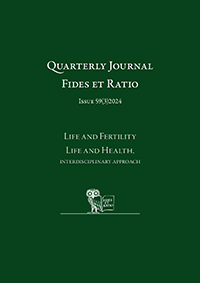Abstract
Introduction: Falling fertility rates and prevalence of infertility become serious problems of public health that affect families all over the world. Both men and women are delaying parenthood for several reasons, such as undertaking further education, pursuing careers, travelling, finding a partner later in life and facing the challenges of establishing secure finances and housing. Unfortunately their fertility declines with age and this awareness may influence the prioritization of life plans. Medical students are specially dedicated to promote health literacy in their future practice as well as in they private life. Aim of the study and methodology: Aim of this study was to examine polish medical students’ awareness about the basic reproductive physiology. It was based on on-line authors’ own questionnaire among 445 female and 97 male medical students of a mean age 22.3 years from 13 polish medical universities. Results It showed that awareness of basic fertility physiology is on relatively high level what can be promising. Students who plan to start a family in the future have the highest overall mean score of correct answers (83%). Statistically lower levels of knowledge about fertility is presented by the students that have no decision about the future family or do not want to raise a family (80% and 72% respectively). The results seem to be similar irrespective of the participants’ gender, year of study, sexual activity and potential pregnancy prevention method. Conclusions It is still essential to introduce modern knowledge about fertility care and prophylaxis issue among future medical staff, so that they will properly take care of their health and educate their patients.
References
Babakhanzadeh, E., Nazari, M., Ghasemifar, S., & Khodadadian, A. (2020). Some of the factors involved in male infertility: A prospective review. International Journal of General Medicine, 13, 29-41.
Berrington, A. (2004). Perpetual postponers? Women’s, men’s and couple’s fertility intentions and subsequent fertility behaviour. Population Trends, 117, 9-19.
Centers for Disease Control and Prevention. (2021). 2021 National ART Summary. U.S. Department of Health and Human Services. (From:) https://www.cdc.gov/art/reports/2021/summary.html (access: 30.05.2024).
Chawłowska, E., Lipiak, A., Krzysztoszek, J., Krupa, B., & Staszewski, R. (2020). Reproductive health literacy and fertility awareness among Polish female students. Frontiers in Public Health, 8, 499. https://doi.org/10.3389/fpubh.2020.00499
Grace, B., Shawe, J., & Stephenson, J. (2023). Exploring fertility knowledge amongst healthcare professional and lay population groups in the UK: a mixed methods study. Human Fertility, 26(2), 302-311. https://doi.org/10.1080/14647273.2022.2153349
Halczuk, A., Sieńko, A., & Kowalczuk, D. (2019). Factors influencing the sexuality education among students in Poland – a survey study. Journal of Education, Health and Sport, 9(7), 611-619. (From:) https://apcz.umk.pl/JEHS/article/view/7179 (access: 13.05.2024).
Harper, J., Boivin, J., O’Neill, H.C., Brian, K., Dhingra, J., Dugdale, G., Edwards, G., Emmerson, L., Grace, B., Hadley, A., Hamzic, L., Heathcote, J., Hepburn, J., Hoggart, L., Kisby, F., Mann, S., Norcross, S., Regan, L., Seenan, S., Stephenson, J., Walker, H., Balen, A. (2017). The need to improve fertility awareness. Reproductive Biomedicine & Society Online, 4, 18-20. https://doi.org/10.1016/j.rbms.2017.03.002
Ibeziako, O.J. (2022). Natural family planning, an option in reproductive healthcare: A qualitative study on clinicians’ perceptions. The Linacre Quarterly, 89(3), 298-318.
Mills, T.A., Lavender, R., & Lavender, T. (2015). “Forty is the new twenty”: an analysis of British media portrayals of older mothers. Sexual & Reproductive Healthcare, 6(2), 88-94.
Nazaré, P.F., Fernandes Pais, A.S., & Figueiredo-Dias, M. (2022). Postponing motherhood: A demographic and contemporary issue. Current Women’s Health Reviews, 18(1), 28-36.
Nouri, K., Huber, D., Walch, K., Promberger, R., Buerkle, B., Ott, J., & Tempfer, C.B. (2014). Fertility awareness among medical and non-medical students: a case-control study. Reproductive biology and endocrinology, 12, 94. https://doi.org/10.1186/1477-7827-12-94
Okine, R., Hughes, L.M., Smith, G., Bonus, M.L., Feinberg, E.C., & Bernardi, L.A. (2023). Undergraduate students have low fertility knowledge and high anxiety regarding future fertility: An opportunity for education. Heliyon, 9(3), e14623. https://doi.org/10.1016/j.heliyon.2023.e14623
Pedro, J., Brandão, T., Schmidt, L., Costa, M.E., & Martins, M.V. (2018). What do people know about fertility? A systematic review on fertility awareness and its associated factors. Upsala Journal of Medical Sciences, 123(2), 71-81. https://doi.org/10.1080/03009734.2018.1480186
Ren, Y., Xie, Y., Xu, Q., Long, M., Zheng, Y., Li, L., & Niu, C. (2023). University students’ fertility awareness and its influencing factors: a systematic review. Reproductive health, 20(1), 85. https://doi.org/10.1186/s12978-023-01628-6
Smoley, B.A., Robinson, C.M. (2012). Natural family planning. American Family Physician, 86 (10), 924-928.
Warzecha, D., Szymusik, I., Pietrzak, B., et al. (2019). Sex education in Poland – A cross-sectional study evaluating over twenty thousand Polish women’s knowledge of reproductive health issues and contraceptive methods. BMC Public Health, 19(1), 689. https://doi.org/10.1186/s12889-019-7046-0
World Health Organization (2023). 1 in 6 people globally affected by infertility. WHO. (From:) https://www.who.int/news/item/04-04-2023-1-in-6-people-globally-affected-by-infertility (access: 09.04.2024).
World Population Review (2023). Average age of having first child by country. (From:) https://worldpopulationreview.com/country-rankings/average-age-of-having-first-child-by-country (access: 04.04.2024).
Zgodzińska, K., Ślizień-Kuczapska, E., Tęsny, T., Czeczelewski, M., Sys, D., & Rabijewski, M. (2023). A cross-sectional study on Polish Medical Students’ knowledge of Fertility Awareness-based Methods. Kwartalnik Naukowy Fides et Ratio, 55(3), 19-26. https://doi.org/10.34766/fetr.v55i3.1195

